Select
Select allows users to choose one option from a list of values.
Overview
The select component collects user-provided information from a list of options. Selects are usually used in forms where a user submits data and chooses one option from a list.
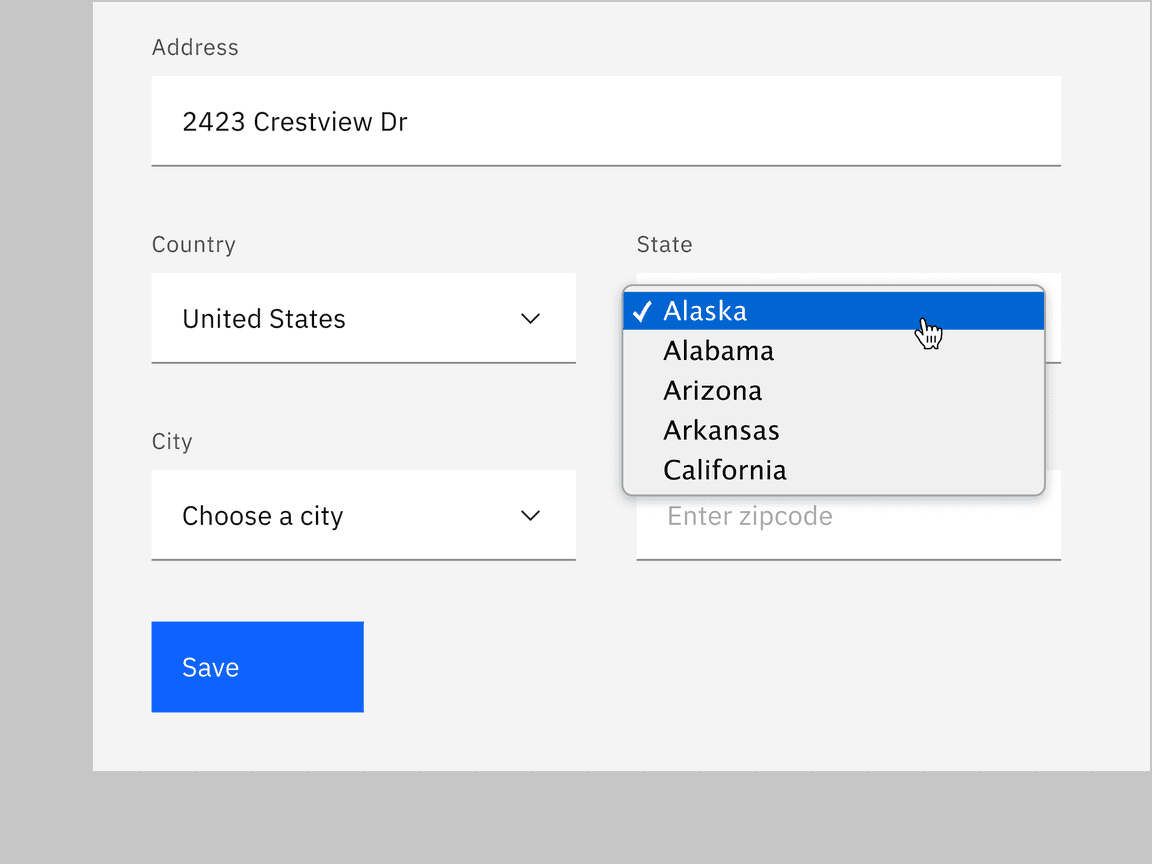
When to use
Use the select component inside a form where users are selecting from a list of options and submitting data.
When the experience is mostly form-based.
When not to use
It is best practice not to use a select if there are fewer than three options for selection. In this case, use a radio button group instead.
Select versus Dropdown
While the select and dropdown components look similar, they have different functions.
A select presents a list of options from which the users can select only one item from that list. It works best in forms when users choose an option from the select list and submit data. It works best in forms when users choose an option from the select list and submit data.
A dropdown presents a list of options that users can select one or several options from that list. Dropdown options are used for taking an action, filtering, or sorting existing content.
Another important difference between the two components is the underlying code. The select component’s appearance will be determined by the browser being used, while the dropdown component can be styled as needed.
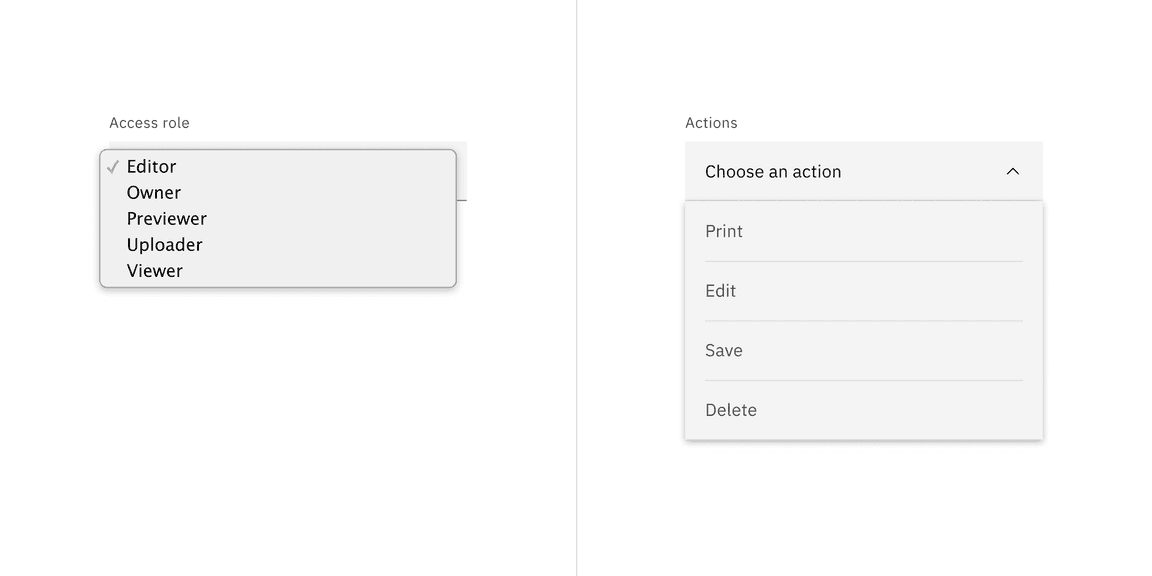
Example of a dropdown list of actional options versus a select list of options for data submission.
Live demo
<SelectdefaultValue="placeholder-item"helperText="Optional helper text"id="select-1"invalidText="A valid value is required"labelText="Select"><SelectItemtext="Choose an option"value="placeholder-item"/><SelectItemGrouplabel="Category 1"><SelectItemtext="Option 1"value="option-1"/><SelectItemtext="Option 2"value="option-2"/></SelectItemGroup><SelectItemGrouplabel="Category 2"><SelectItemtext="Option 3"value="option-3"/><SelectItemtext="Option 4"value="option-4"/></SelectItemGroup></Select>
Variants
| Variant | Purpose |
|---|---|
| Default | Typically used in forms with a variety of other components. |
| Inline select | Used when there are multiple select fields within a form. |
Default select
Default selects are used in forms with other components.
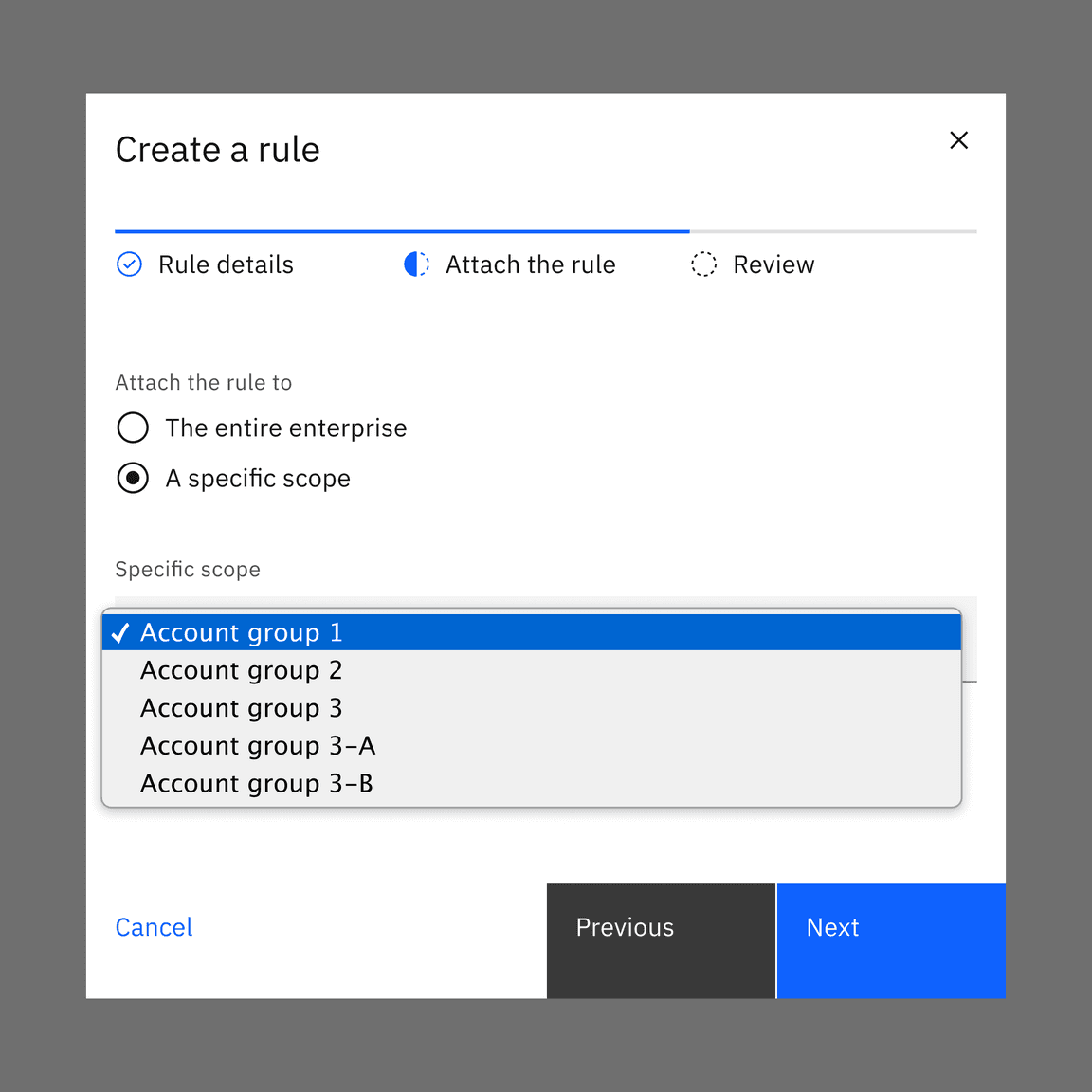
Inline select
Inline select is useful when you have multiple select fields within a form. Inline selects have less visual weight on a page because they are borderless.
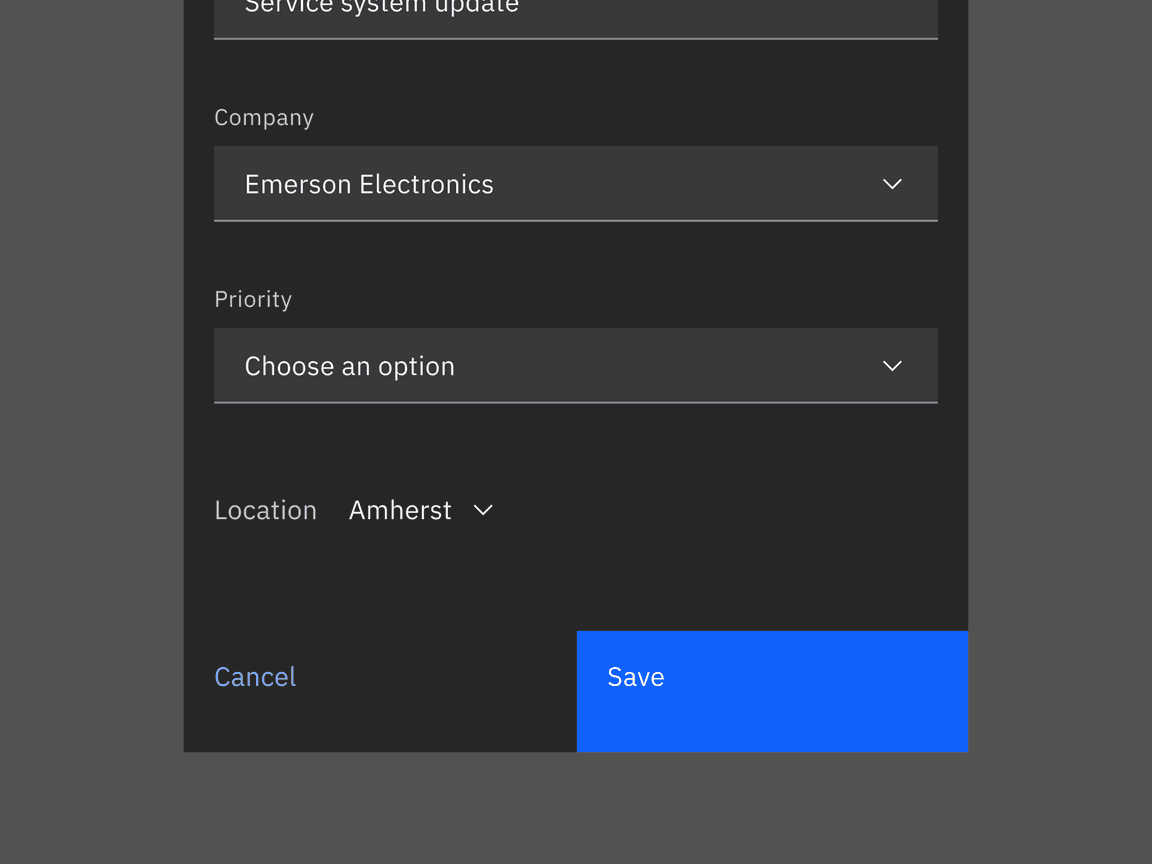
Formatting
Anatomy
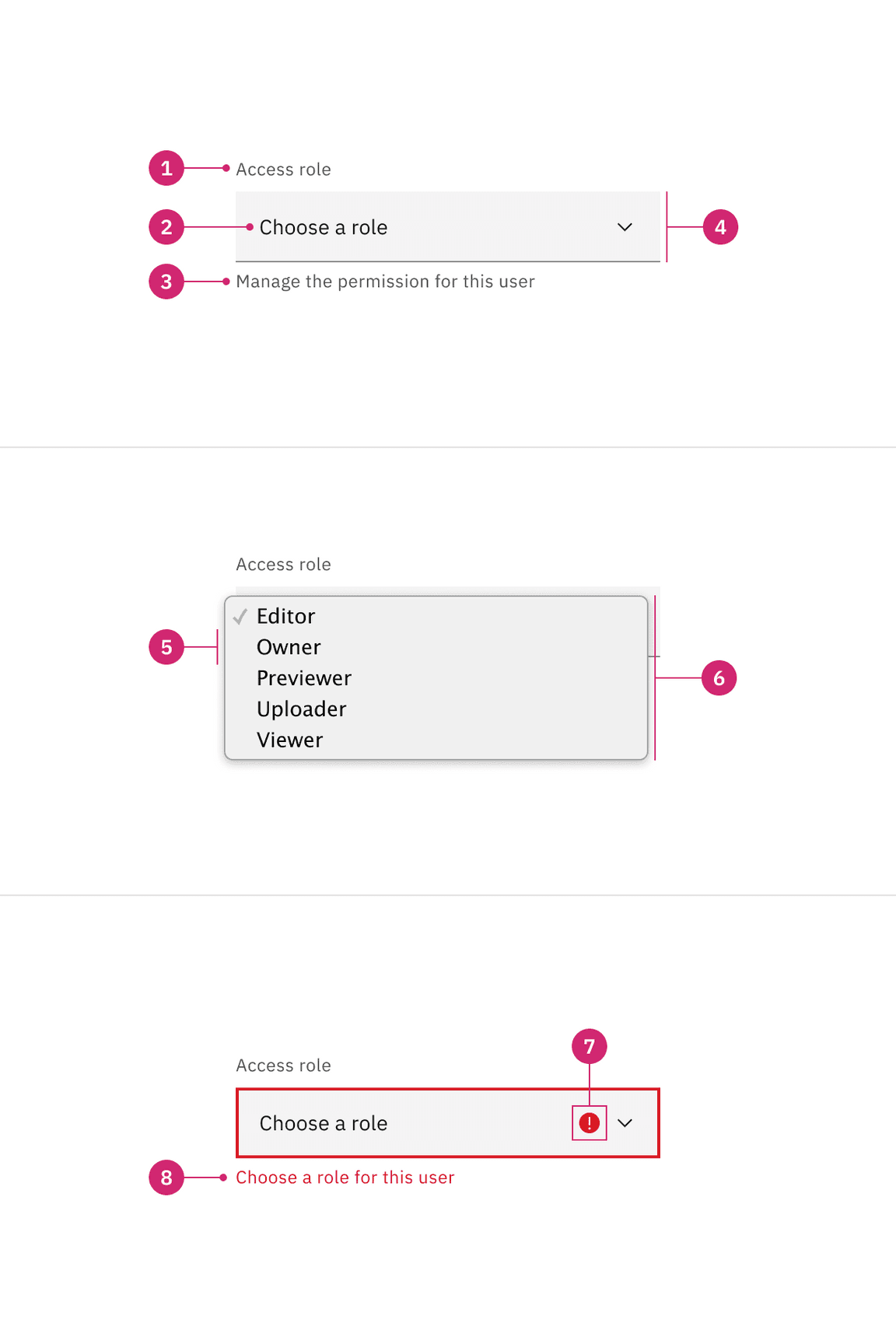
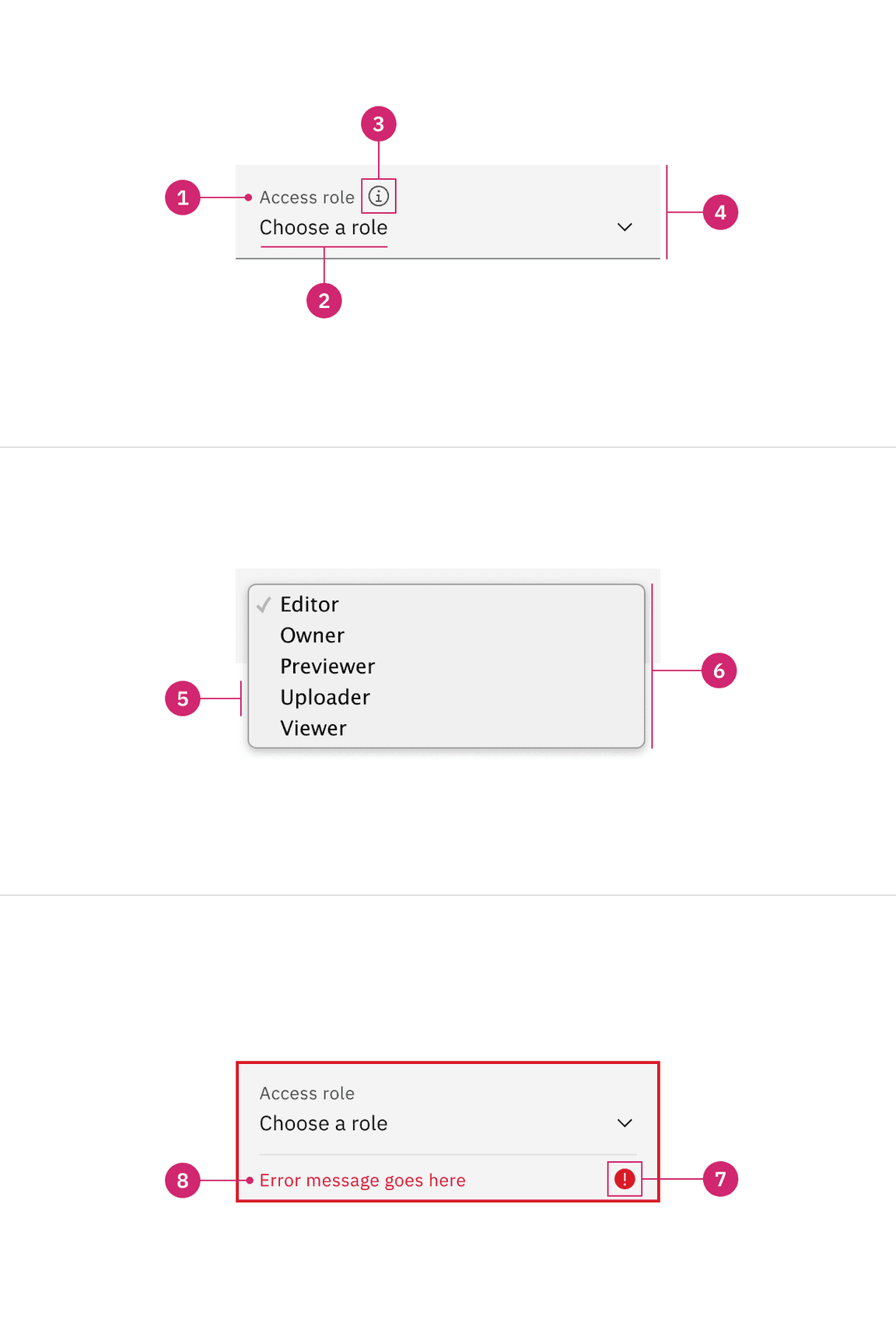
- Labels: Text that informs the user what to expect in the list of dropdown options.
- Default option: Usually a frequent option that users would choose from a select list.
- Helper text (optional, except for error and warning): Assistive text to help the user choose the right selection. Helper text is shown in a tooltip for fluid styles.
- Field: Persists when the dropdown is open or closed.
- Option: A choice for the user, shown with other choices in a menu.
- Menu: A list of options to choose from, displayed as an open state.
- Status icon: Indicates the state of the select, either error or warning.
- Error or Warning text: It replaces the helper text when an error or warning state appears.
Styling
There are two styles of select inputs, fixed and fluid. They share the same functionality but look visually different, influencing where to use them.
| Style | Appearance | Use case |
|---|---|---|
| Fixed | A traditional style where the label is positioned outside and above the input field. | Use when white space is needed between input components or in productive moments where space is at a premium, and smaller components are needed. |
| Fluid | An alternative style where the label is placed inside of the input field and is stacked inline with the user input text. | Use in expressive moments, fluid forms, contained spaces, or attached to complex components, like a toolbar. |
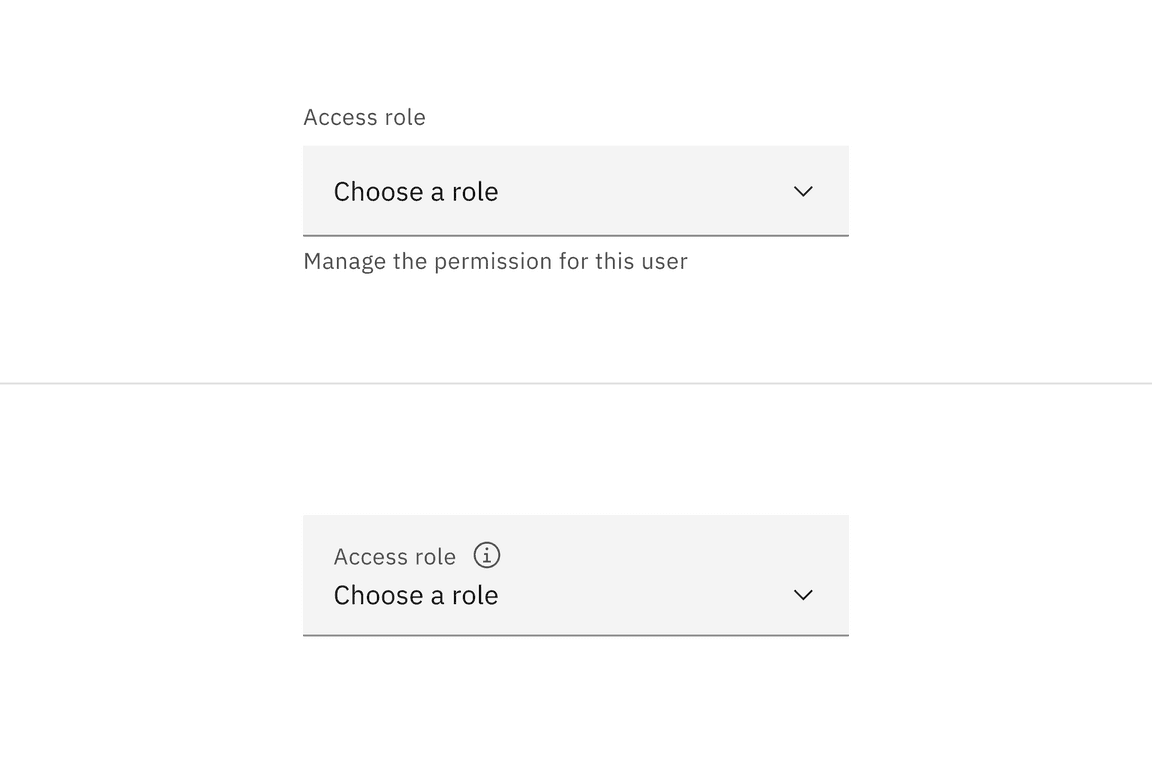
Sizing
Fixed input heights
There are three fixed select height size for both variants: small, medium, and large. Supporting three different select sizes gives you more flexibility when structuring layouts. However, use a consistent size for all form components on the same page. For example, if you are using a medium size select also use the same size text inputs, buttons, and so on. When in doubt, use the default medium size height.
| Fixed size | Height (px/rem) | Use case |
|---|---|---|
| Small (sm) | 32 / 2 | Use when space is constricted or when placing a select in a form that is long and complex. |
| Medium (md) | 40 / 2.5 | This is the default size and the most commonly used size. When in doubt, use the medium size. |
| Large (lg) | 48 / 3 | Use when there is a lot of space to work with. The large size is typically used in simple forms or when a select is placed by itself on a page. |

Fluid inputs heights
In the fluid select, there is only one input height. The menu height is controlled by the browser.
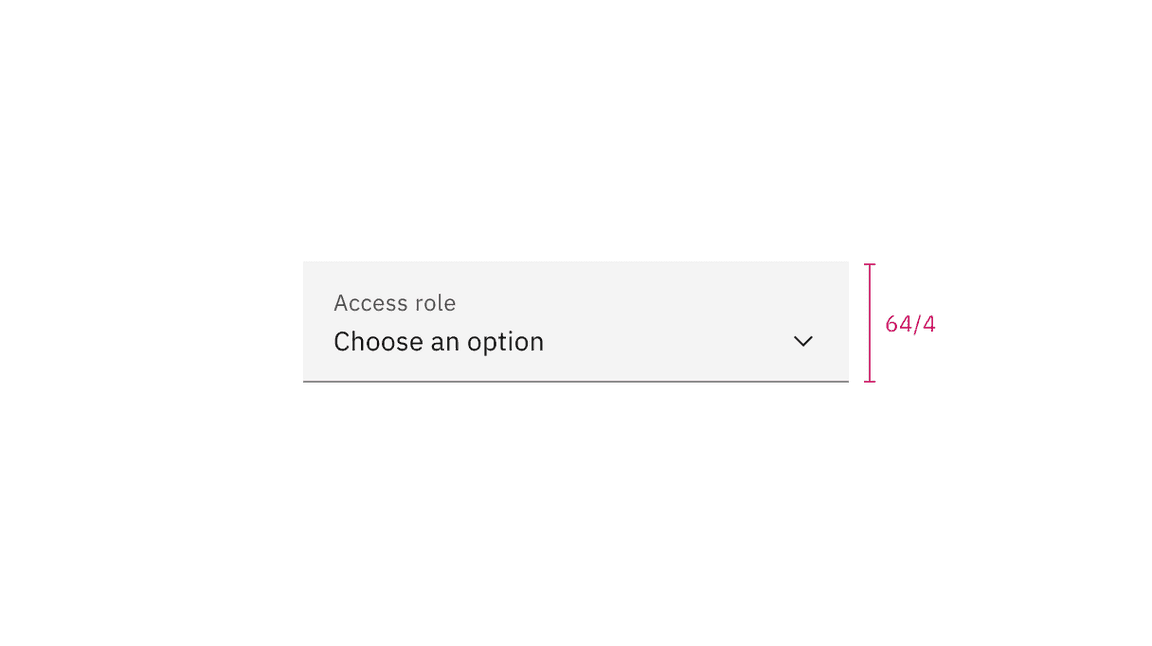
Width
There is no minimum or maximum width for a select. The width can be customized appropriately for its context.
Content
Main elements
Label
- Labels inform users what to expect in the list of select options.
- Keep the label short and concise by limiting it to a single line of text.
Helper text
- Helper text is pertinent information that assists the user in choosing the right selection from the select menu.
- Helper text is optional but replaced with warning or error text when these states appear.
Order
The order of the select list should be based on the frequency of use. If applicable, the list should be in alphabetical order or in increasing order relative to the content.

Overflow content
Avoid having multiple lines of text per item in a select menu. The menu items should be no longer than three words.
Behaviors
States
The select has multiple interactive states for both default and inline variants: enabled, hover, focus, open, error, warning, and disabled.
| State | When to use |
|---|---|
| Enabled | When the select is live and a user is not directly interacting with it. This is commonly referred to as the default or normal state of the component. An enabled select field should contain a default value. |
| Hover | When a user’s mouse cursor is hovering over the field. |
| Focus | When a user tabs to or clicks on the select field, the field becomes focused, indicating the user has successfully navigated to the component. |
| Error | When the required select value has not been selected. It can also be triggered due to a system error. This state requires a user response before data can be submitted or saved. |
| Warning | When you need to call the user’s attention to an exception condition. The condition might not be an error but can cause problems if not resolved. |
| Disabled | When the user is not allowed to interact with the select due to either permissions, dependencies, or prerequisites. The disabled state completely removes the interactive function from a component. The styling is not subject to WCAG contrast compliance. |
| Skeleton | Used on an initial page load to indicate that the select has not yet fully loaded. |
| Read-only | Coming soon! |
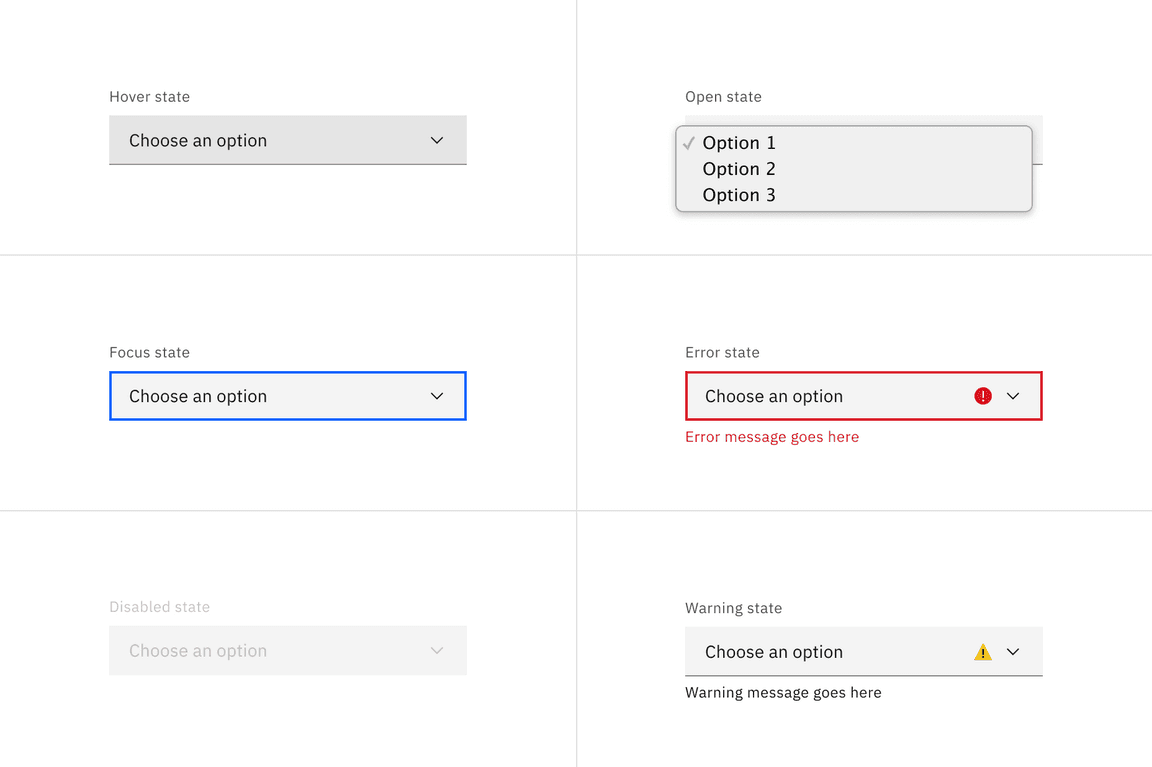
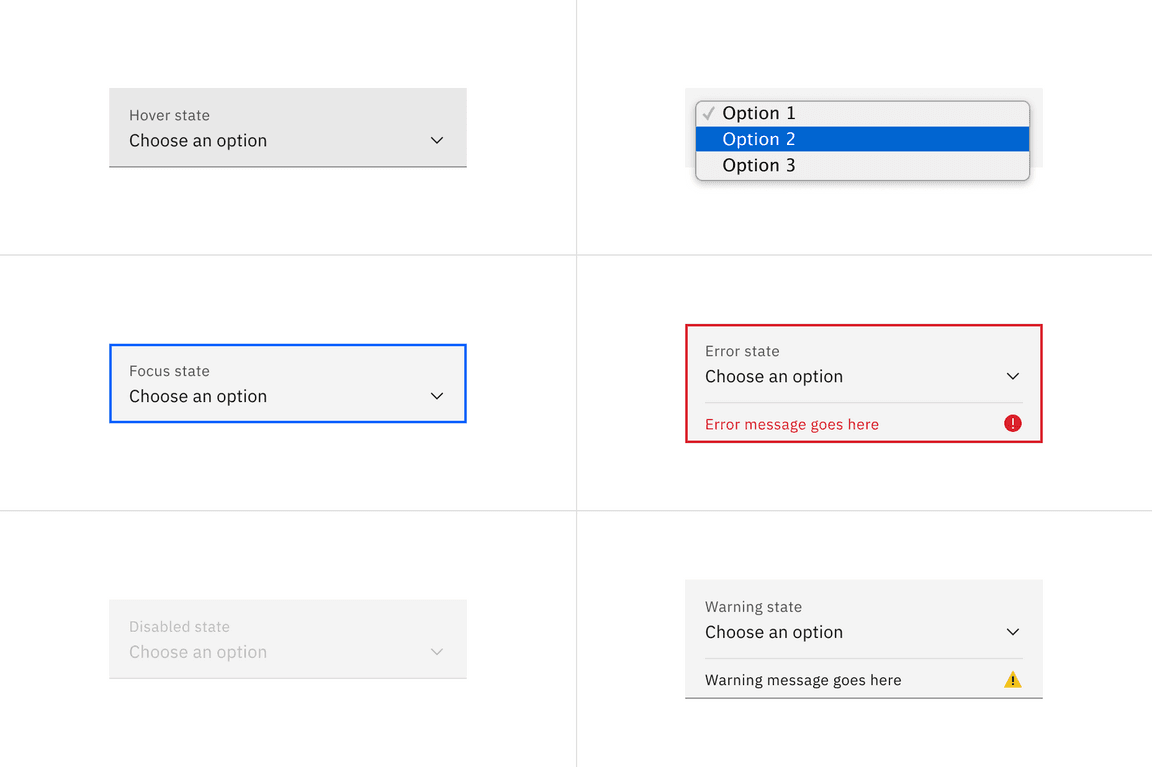
Interactions
Mouse
Users trigger a dropdown menu to open by clicking the chevron icon or clicking anywhere within the field. Users can close the menu by clicking the chevron icon or clicking outside of the menu. To select an option, the user can click anywhere inside an option container.
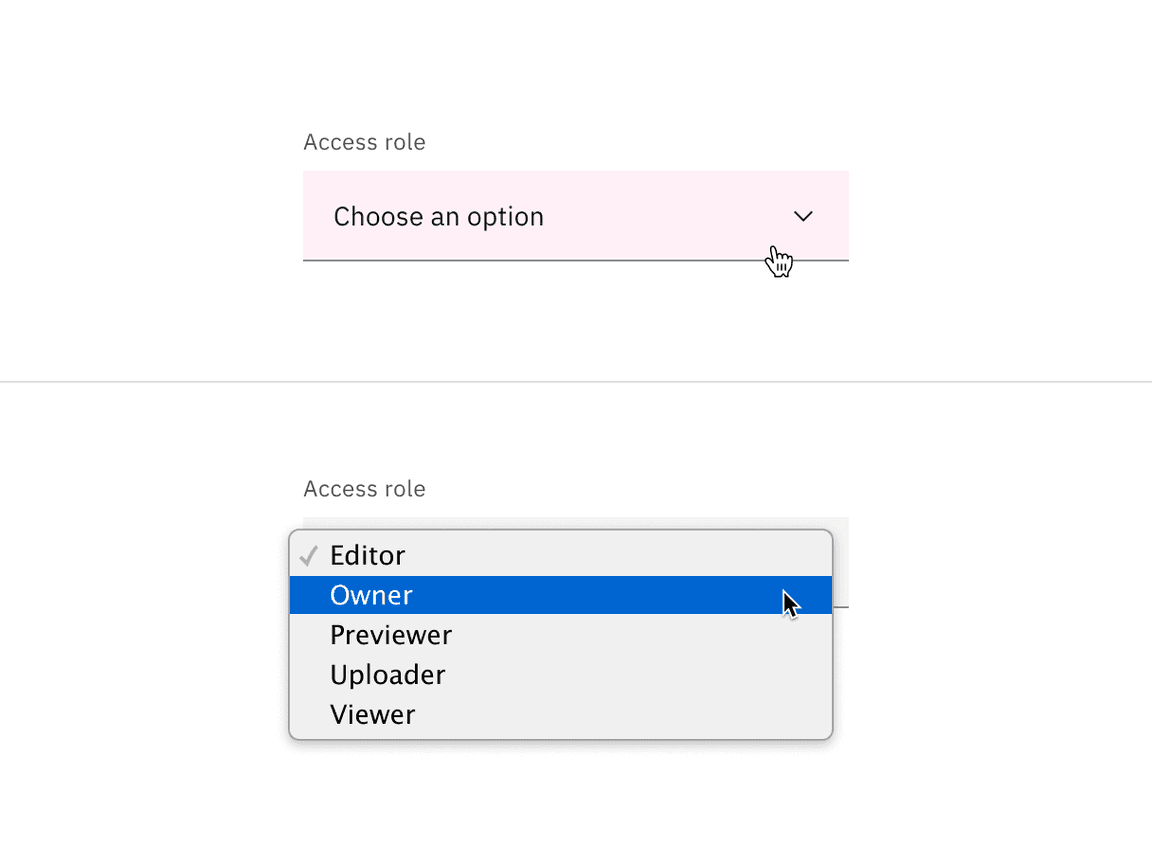
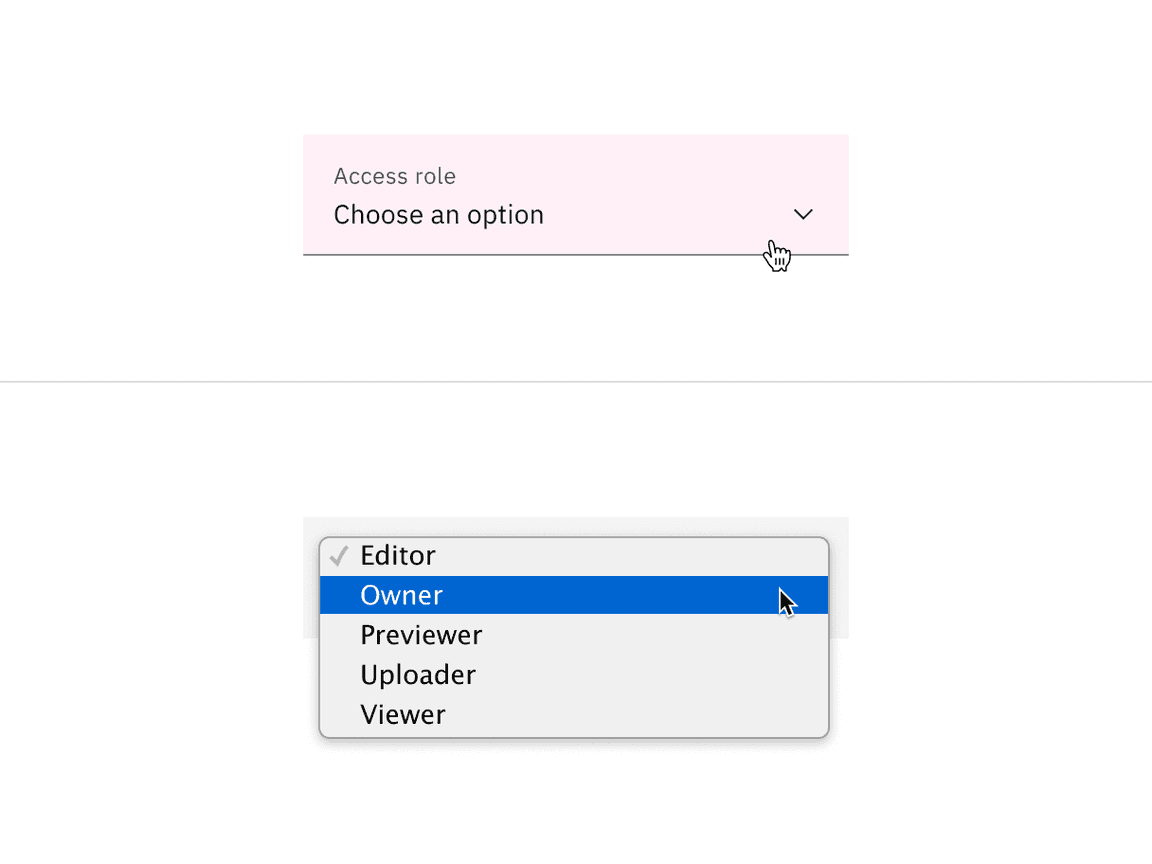
Keyboard
- The dropdown field is the element that receives focus. All keyboard interactions happen from this element.
- Users can open the dropdown menu by pressing
Space,Enter, theDown arrow, or theUp arrow. - Users can move the highlighted option to the next option by pressing the
Down arrow. - Users can move the highlighted option to the previous option by pressing the
Up arrow. - Users can close the dropdown menu by pressing
Escape,Space, orEnter.
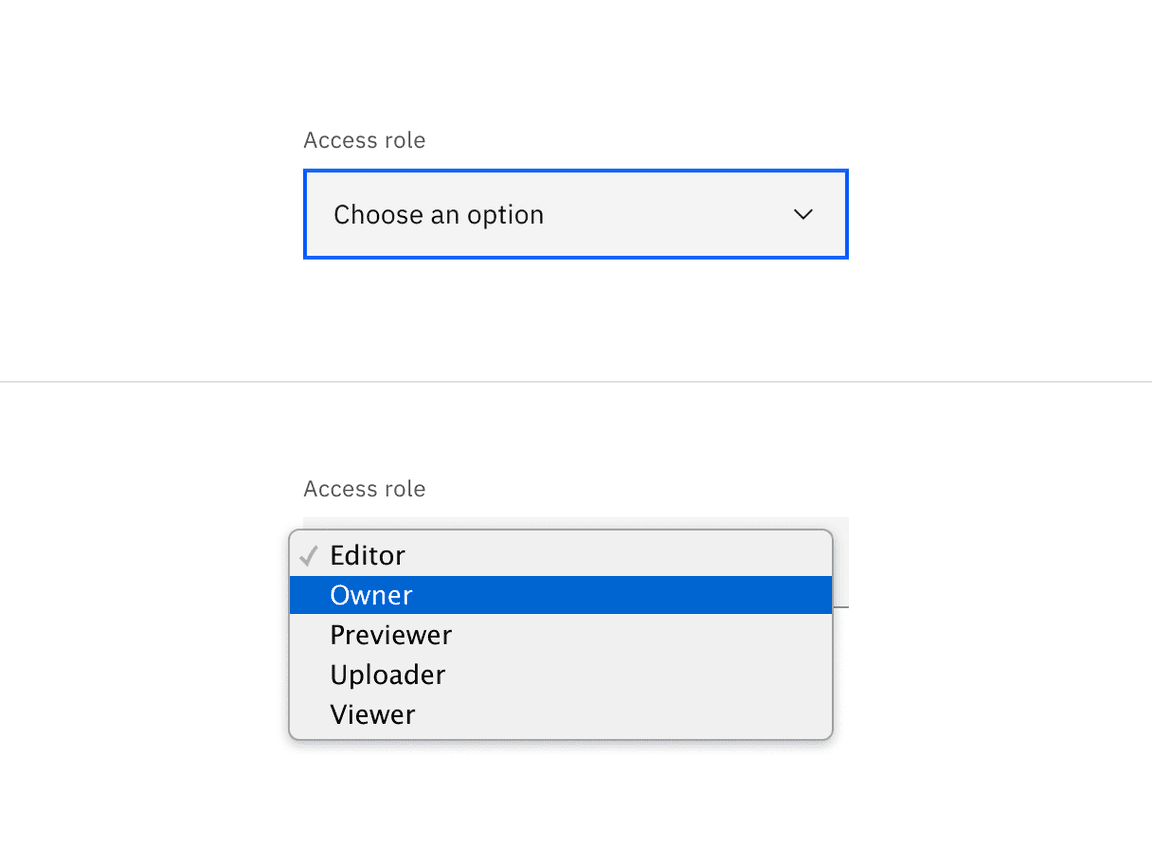
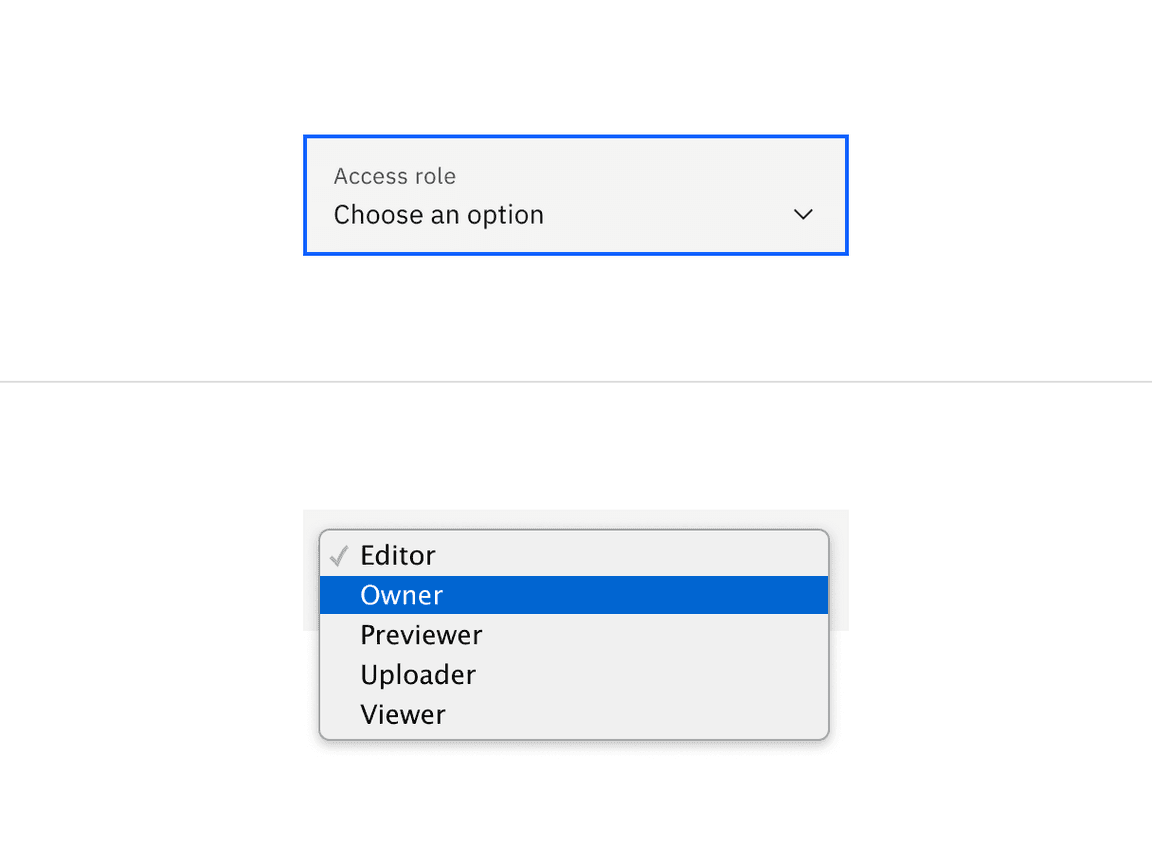
Validation
Invalid
Real-time validation helps to streamline the process of filling out a form. The error state is triggered if the data is invalid or a required field is left empty. The error state has three visual indicators to signify invalid content: a red border, an error icon indicator, and an error message.
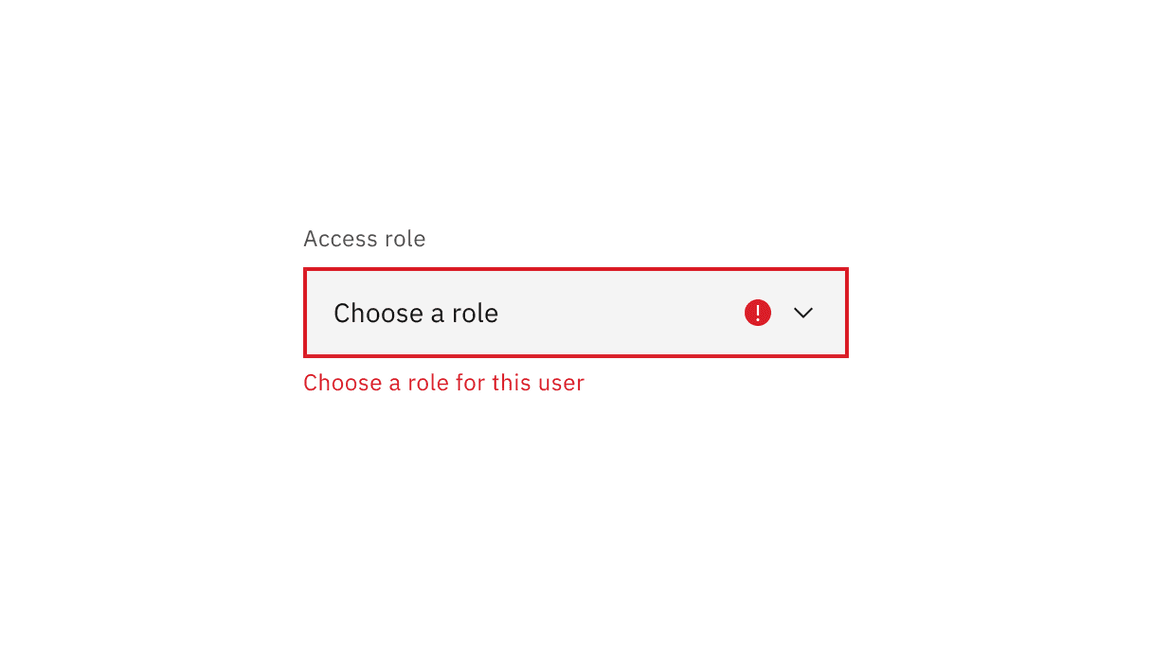

Default selection
By default, the selected option is usually the first item in alphabetical order. The default selection could also be a call-to-action that asks users to select an option from the menu.
Related
- If there are fewer than three options to choose from, use a radio button group instead.
- If multi-select is necessary, use dropdown instead. Dropdown options are used to take an action, navigating outside of the current context, filtering or sorting existing content.
Feedback
Help us improve this component by providing feedback, asking questions, and leaving any other comments on GitHub.